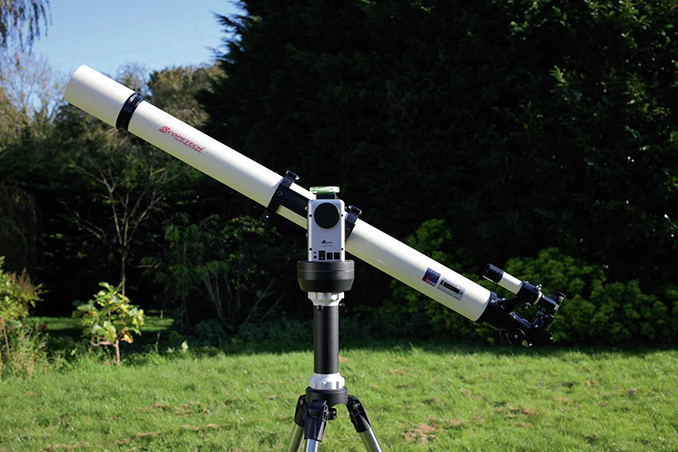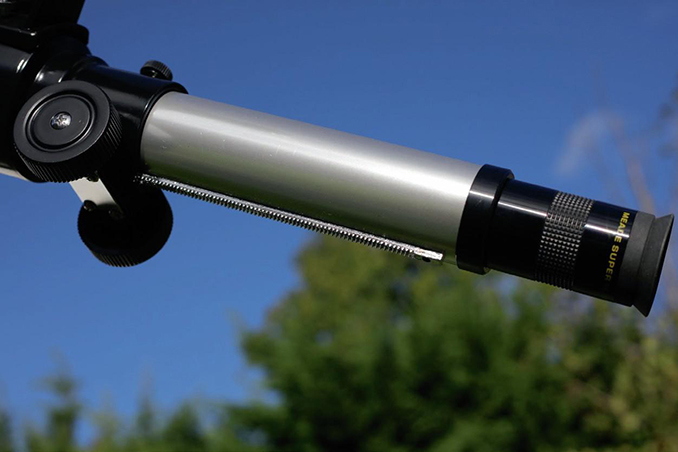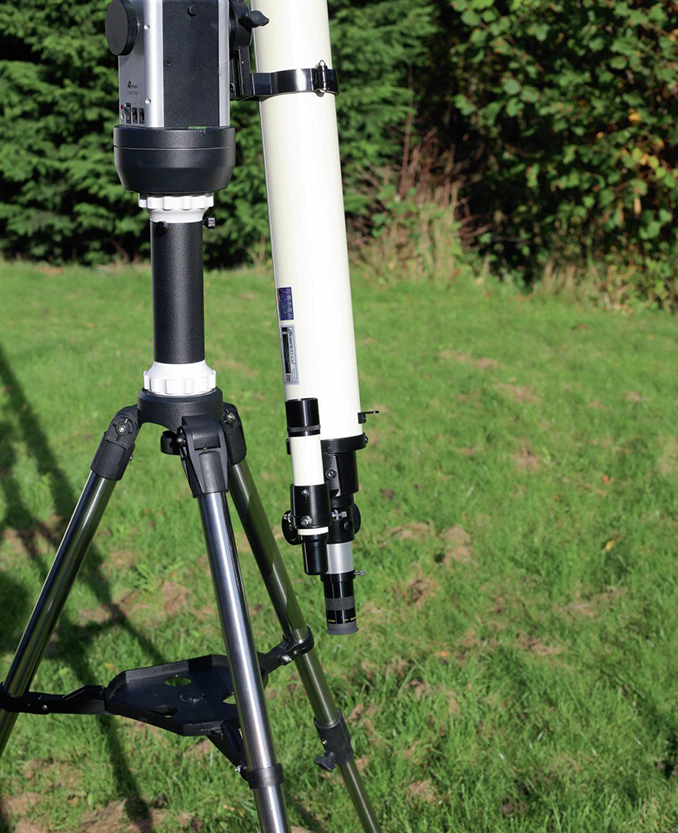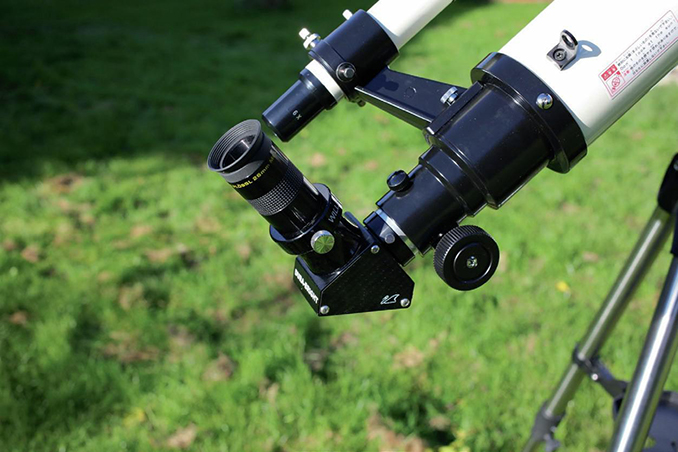ScopeTech’s STL-80A Maxi, f/15 refractor – Astronomy Now

Although exotic Extra-low Dispersion (ED) glasses have enabled triplet apochromatic refractors to invade the chromatic aberration-free province hitherto dominated by reflectors, it should be remembered that doublet achromatic refractors have long been achieving pretty much the same success by employing high focal-ratios.
ScopeTech’s STL-80A Maxi, f/15 refractor, a review model of which was provided by First Light Optics, continues in that fine tradition.
It’s certainly not one of those modern refractors that are attempting to fit into a shoebox. Out of its roomy packing comes a sleek, gleaming white tube fully 1.25 metres long. It comes fitted with a tube ring/dovetail unit that has sufficient space for a hand to pass through, therefore doubling as a handle.
The optics comprise an 80mm doublet of 1,200mm focal length, resulting in a focal ratio of f/15. This is certainly not a ‘dumper truck’ rich-field instrument, but a ‘racing car’ aimed at getting up close and personal. The focuser is a very smooth 1.25-inch-fitting rack-and-pinion type with a locking/tension adjustment thumbscrew. The eyepiece clamp is a single screw rather than a brass compression ring, which is a bit of a shame given how ubiquitous the latter has become. The side of the tube is adorned by a pair of small (luminously painted) ‘gunsight’ rings, useful for approximate pointing at the Moon, planets and bright stars, while lensed alignment is achieved by the supplied 6 × 30mm finder. With a focal ratio of f/15, this is certainly not a ‘dumper truck’ rich-field instrument, but a ‘racing car’ aimed at getting up close and personal
In use
Most of the testing was assisted by my GoTo alt-az iOptron CubePro mount, with occasional ‘support’ from ScopeTech’s Mount Zero, which I reviewed in the October 2021 issue of Astronomy Now – although the latter is not a GoTo (yet!).
My first job (in daylight) was to fit and align the 6 × 30mm finder. This was straightforward enough, although the finder tube is clamped by a single screw at one end and collimated by three at the other. I always find this system unduly fiddly (as I did this time) and much prefer the paired three-screw systems – which generally allow greater flexibility and accuracy. For the additional manufacturing cost of just three small screws, why not?
As dusk fell, Jupiter was the first to show itself in a deepening turquoise sky. I chose a 40mm orthoscopic eyepiece to begin with, wanting a low power initially to get a stand-back view of the Jovian system. This delivered a magnification of 30×, which yielded a very pleasant view of all four Galilean moons and a bright, sharply defined planetary disc that (although glaringly bright) was already horizontally sliced by equatorial belts.
With the seeing conditions reasonably good, I pitched the power up to 92× with a 13mm superwide Plössl, at which point the telescope began to deliver worthwhile detail. The eyepiece’s 84-degree apparent field translated into a real-sky view of almost one degree, meaning that I could still encompass planet and moons, with Jupiter now displaying clean belt detail.
At 200× using a 6mm eyepiece, I was more than happy with the amount of detail being elicited. I was pleased to see that the subtle pastel grey-blues and rusty browns of Jupiter’s belts were well shown.
Of course, it must be added here that one of the advantages of a relatively long-focus refractor of 1,200mm focal length, compared to a typical apochromat of 400mm, is that the same eyepiece will supply higher power while retaining comfortable eye relief. For instance, the ScopeTech’s focal length of 1,200mm will deliver a magnification of 60× through a userfriendly 20mm eyepiece, yet with a 400mm instrument you would need to squint through the relatively smaller portal of a 7mm eyepiece to approach the same power.




A 4mm eyepiece at 300× was still rewarding, but probably an option retained for occasional nights of best seeing. In trawling through my eyepiece selection, I found that an optimal high power was delivered by an 8mm eyepiece – at 150×. This closely matches the general guiding maxim that greatest useful magnification equates to about 50× the aperture in inches.
Although it was long past its August opposition, I caught a low-elevation Saturn before it made its escape behind nearby rooftops. Saturn never disappoints and this telescope is an ideal instrument for it. It happily accepted use of my 6mm eyepiece, giving 200×. The view was stunning. The Cassini Division was clearly delineated, as was the shadow of the rings on the planet and that of the planet on the rings. Titan of course hovered in close attendance, helping to give the field that dramatic 3D feel that Saturn supplies so well.
The ScopeTech’s focal length of 1,200mm will deliver a magnification of 60x through a user-friendly 20mm eyepiece
Deep-sky prowess
Yet a long tube can have its drawbacks. With potentially greater momentum at either end than with a short instrument, vibration can be a problem. Those considering a purchase of this f/15 need to ensure that a mount’s payload specification considerably exceeds the nominal 2.8-kilogram total weight (with the tube rings and finderscope added) of the ScopeTech STL-80A Maxi.

Yet despite showing its prowess at providing excellent planetary detail, I was interested to discover how successful it might be at the other end of the observing scale, on deep-sky objects –a field of observation almost contrary to this telescope’s natural prey.
I brought the telescope back to a wider field of about 1.5 degrees with my 40mm orthoscopic eyepiece, and turned my gaze high towards the north-east and the Pleiades (M45). The eyepiece could not encompass the almost two-degree span of this cluster, but what it did show was still breathtaking. Most of the major components were captured and stood in the field sharply defined against a dark backcloth.
Of course, almost overhead in the autumn sky hovered the deep-sky magnet of the Andromeda Galaxy (M31). With the long tube pointing almost to the zenith, the intervention of a star diagonal was now a requirement in order to avoid a subsequent visit to a chiropractor. I am pleased to say that even at f/15, the Andromeda Galaxy’s core was bright and condensed, with a misty ellipse falling away towards the periphery of the field. It was a great view.
Star diagonal
However, deployment of the diagonal did reveal an oddity. A telescope of this focal length will, by its nature, occasionally need eyepieces to be used with a star diagonal (especially for zenith observations), unless the tube is installed on an unusually high mount. Yet I found by experiment that some of the twenty-one 1.25-inch eyepieces that I had at my disposal (of all designs, focal lengths and ages) were unable to be racked in far enough to achieve focus with the star diagonal in place. With the least atmospheric interference, zenith observations can be the best available, but I had no wish to drop to my knees or lie on the ground to access them. Is this lack of infocus betraying a Japanese aversion towards star diagonals? Perhaps. But for a wider market this aspect needs to be reviewed.
If this were my purchase, I would probably shave one to two inches from the main tube and refit the focuser – but obviously this was not an option on a review item! I circumvented the problem by inserting my star diagonal first into a Barlow lens – which has the effect of extending back-focus, but at the expense of increasing effective focal length and therefore magnification.
From the constellation of Andromeda, I swept westwards across the sky to alight on the Ring Nebula (M57), still riding high despite the advance of autumn. At low power it was tiny, but intense.
I increased its scale by boosting it to a ‘planetary’ power of 150×. Although not a ‘light bucket’ by any means, the telescope’s 80mm aperture was still able to pull sufficient light in to clearly depict the nebula’s smoke ring with good contrast.
While in Lyra, I skipped to the northern part of the constellation and alighted on epsilon Lyrae to see how well the ScopeTech would perform on another of a long refractor’s classic strengths, that of close double-star observation. Epsilon…
Read More: ScopeTech’s STL-80A Maxi, f/15 refractor – Astronomy Now

